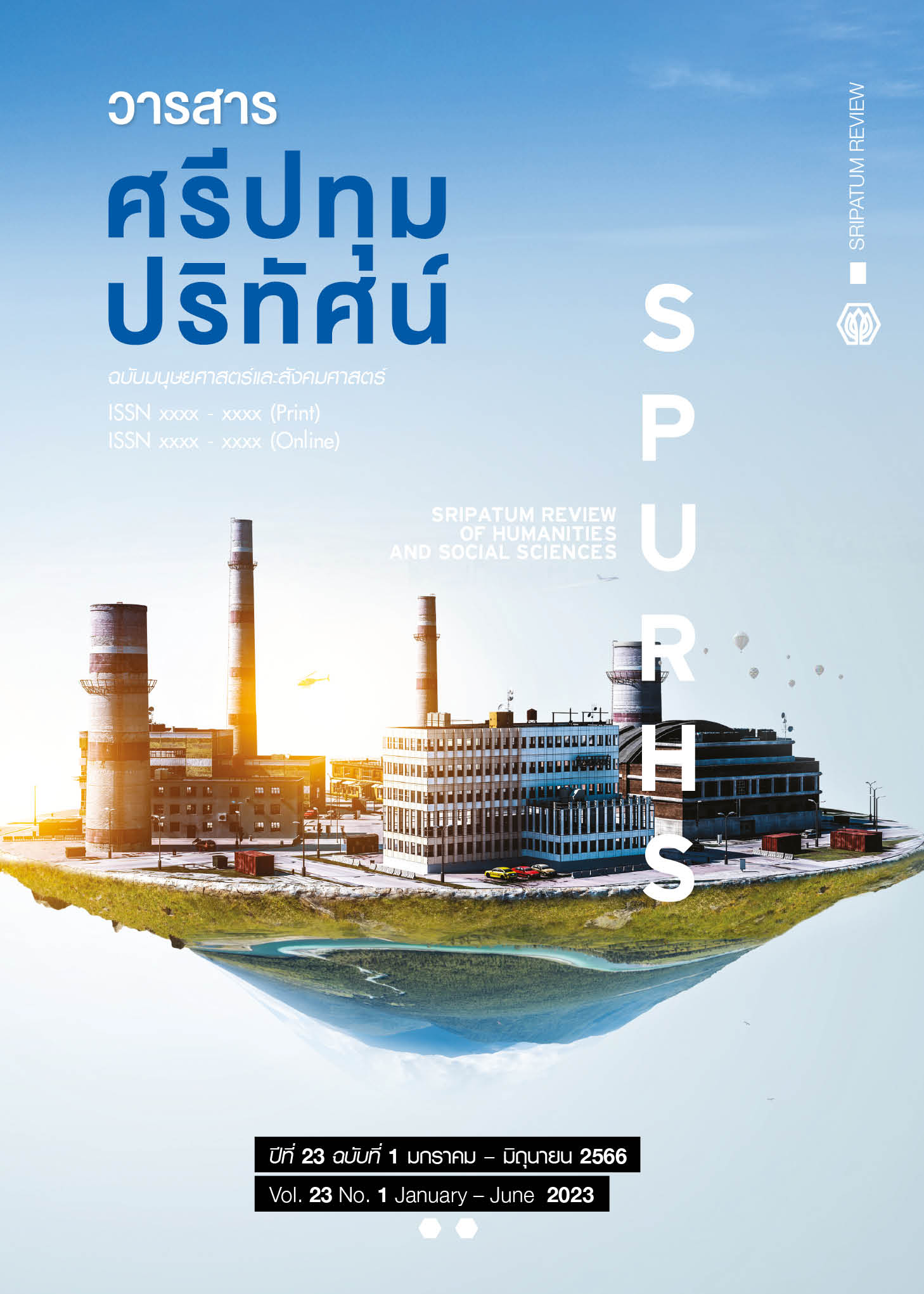แบบจำลองการพัฒนาเมืองอัจฉริยะสำหรับรองรับการเข้าสู่สังคมผู้สูงอายุ (A Model for Smart City Development for Aging Society)
Main Article Content
บทคัดย่อ
การวิจัยนี้มีวัตถุประสงค์เพื่อ (1) ศึกษาปัจจัยการพัฒนาเมืองอัจฉริยะสำหรับรองรับการเข้าสู่สังคมผู้สูงอายุ และ(2) สร้างแบบจำลองการพัฒนาเมืองอัจฉริยะสำหรับรองรับการเข้าสู่สังคมผู้สูงอายุ ประชากรและกลุ่มตัวอย่างที่ใช้ในการศึกษาคือ ประชาชนในเขตเทศบาลนครนนทบุรี จำนวน 400 คน เครื่องมือที่ใช้ในการเก็บข้อมูลคือ แบบสอบถาม มีค่าความเชื่อมั่นเท่ากับ 0.94 วิเคราะห์ข้อมูลด้วยสถิติพรรณนา การวิเคราะห์องค์ประกอบและความสัมพันธ์ของตัวแปรที่ศึกษาด้วยโปรแกรมสำเร็จรูป ผลการวิจัยพบว่า (1) ปัจจัยการพัฒนาเมืองอัจฉริยะมีผลกระทบทางบวกต่อการเข้าสู่สังคมผู้สูงอายุ และ(2) แบบจำลองการพัฒนาเมืองอัจฉริยะมีความสอดคล้องกับการเข้าสู่สังคมผู้สูงอายุ โดยค่าสถิติมีความสอดคล้องกับข้อมูลเชิงประจักษ์อยู่ในเกณฑ์ที่ยอมรับได้ทุกค่า แสดงให้เห็นว่าการพัฒนาเมืองอัจฉริยะมีศักยภาพในการรองรับสังคมผู้สูงอายุได้
Article Details

This work is licensed under a Creative Commons Attribution-NonCommercial-NoDerivatives 4.0 International License.
1. กองบรรณาธิการสงวนสิทธิ์ในการพิจารณาและตัดสินการตีพิมพ์บทความในวารสาร
2. บทความทุกเรื่องจะได้รับการตรวจสอบทางวิชาการโดยผู้ทรงคุณวุฒิ แต่ข้อความและเนื้อหาในบทความที่ตีพิมพ์เป็นความรับผิดชอบของผู้เขียนแต่เพียงผู้เดียว มิใช่ความคิดเห็นและความรับผิดชอบของมหาวิทยาลัยศรีปทุม
3.การคัดลอกอ้างอิงต้องดำเนินการตามการปฏิบัติในหมู่นักวิชาการโดยทั่วไป และสอดคล้องกับกฎหมายที่เกี่ยวข้อง
References
Angsuchot, S. et al., (2011). Analytical statistics for research in social sciences and behavioral sciences: LISREL program techniques. Bangkok: Charoendee Munkong Printing, 2011. (in Thai)
Angsukanjanakul, J. (2017). Modeling Sustainable Management for Community-based Tourism: A Case Study of Floating Markets in the Lower Central Thailand. International Journal of Management and Applied Science., 3(1), 43-46.
Bentler PM. (1990). Comparative Fit Indexes in Structural Models. Psychological Bulletin, 107 (2), 238-246. doi: 10.1037/0033-2909.107.2.238.
Byrne, B.M. (1989). A Primer of LISREL: Basic Applications and Programming for Confirmatory Factor Analytic Models. New York: Springer-Verlag Publishing.
Cronbach, L. J. (1970). Essentials of Psychological Test. 5th ed. New York: Harper Collins.
Digital Economy Promotion Agency (2020). Driving Smart City Development Policy of Thailand. [Online]. Retrieved June 16, 2022., from: https://www.depa.or.th/th/digitalservice/digital-transformation-Fund-for-community [in Thai]
Glasmeier, A. and Christopherson, S. (2015). Thinking about smart cities. Cambridge Journal of Regions, Economy and Society, 8(1), 3-12.
Gottlieb, B. H. and Bergen, A. E. (2010). Social support concepts and measures. Journal of Psychosomatic Research, 69(5), 511-520.
Hair, J. et al. (1995). Marketing education in the 1990's: a chairperson's retrospective assessment and perspective. Marketing Education Review, 5(2), 1-6.
Hair, J. et al. (2006). Multivariate data analysis. 6th ed. Pearson Prentice Hall: New Jersey.
House, J. S. (1981). Work Stress and Social Support. Reading, Mass: Addison-Wesley.
Jenrangsan, S. (2019). Developing the municipality to be a smart city in the area of Khon Kaen. Journal of Buddhist Education and Research, 5(2), 361-375. (in Thai)
Kelloway, K. E. (1998). Using LISREL for Structural Equation Modeling: A Researcher’s Guide. Thousand Oaks, CA: Sage Publications.
Kim, J. O. and Mueller, C. W. (1978). Factor Analysis: Statistical Methods and Practical Issues. Beverly Hills, CA: Sage.
King Prajadhipok's Institute. (2019). Local Development into Sustainable Smart Cities, [Online]. Retrieved June 16, 2022., from: https://kpi.ac.th/knowledge/book/data/888?page=6. (in Thai)
Kittinaraporn, J. (2020). Factors Affecting Smart City: A Case Study of Tha Khong Municipality. Journal of Communication Arts Ramkhamhaeng University, 24(1), 71-81. (in Thai)
Klosawat, K. (2019). Comparing indicators of smart economy cities. Saeng Isan Journal Mahamakut, Wittayalai University, Northeastern Campus, 16(2), 558-574 (in Thai)
Local Government Organizations (2020). What is a Smart City and how will it happen? [Online]. Retrieved June 16, 2022., from: https://www.engineeringtoday.net [in Thai]
Meijer, A. and Bolivar, M. P. R. (2016). Governing the Smart City: A Review of the Literature on Smart Urban Governance. International Review of Administrative Sciences, 82, 1-17.
Nonthaburi Municipality. (2023). Nakornnont Smart City. [Online]. Retrieved April 23, 2023, from: https://nakornnont.go.th/news/detail/7152 (in Thai)
Nonthaburi Municipality Local Registration Office. (2022). General information Nonthaburi Municipality. [Online]. Retrieved June 16, 2022, from: https://www.nakornnont.go.th/content/general. (in Thai)
Rovinelli and Hambleton. (1977). On the use of content specialists in the assessment of criterion-referenced test item validity. Dutch Journal of Educational Research, 2, 49-60.
Smart City Thailand Office (2020). Smart City. [Online]. Retrieved June 16, 2022, from:https://www.depa.or.th/th/digitalservice/smartcity/goals-and-areas. (in Thai)
Sumalee, E. and Tanchai, C. (2019). Smart City. [Online]. Retrieved June 16, 2022, from: https://kpi-lib.com/library/en/books/kpibook-25587/ (in Thai)
Tabachnick, B. G. and Fidell L. S. (2007). Using Multivariate Statistics. 5th Ed. Boston: Pearson Education, Inc.
Tanaka, J. S. and Huba, G. J. (1985). A Fit Index for Covariance Structure Models Under Arbitrary GLS Estimation. British Journal of Mathematical and Statistical Psychology. 38(2), 197-201.
Tapananont, et al. (2018). Smart city development. Unisearch Journal, 5(1), 3-8.
Temperampoon, S. (2020). Success Factors Affecting Smart City Development of the People's Republic of China: A Case Study of Shanghai City. Graduate Studies Journal Valaya Alongkorn Rajabhat University Under the Royal Patronage of His Majesty the King, 14(3), 165-179. (in Thai)
Thongmuenwai, P. (2017). Mechanism of cooperation between government and private agencies in the implementation of smart city development, Research and Development Institute Journal. Mahasarakham Rajabhat University, 4(1), 43-54. (in Thai)

